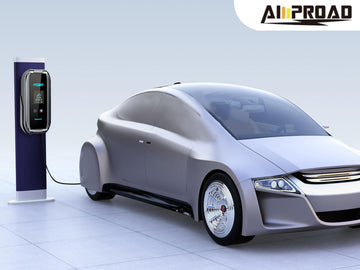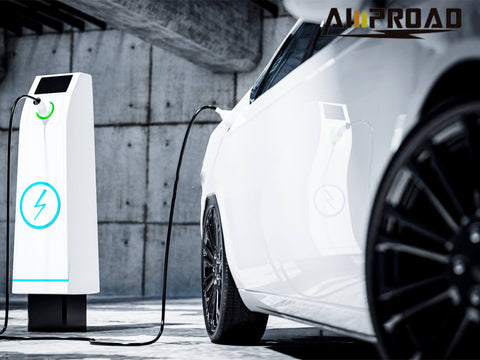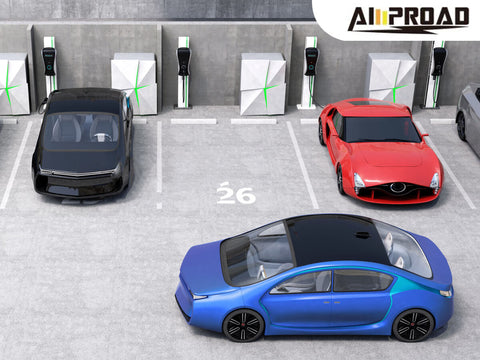
With electric vehicles gaining popularity, understanding charging options is essential for both EV owners and those considering the switch. From home EV chargers to public charging stations and Tesla mobile connector adapters, knowing how to charge efficiently can help extend battery life, lower costs, and support a more sustainable future.
How Long Does It Take to Charge An EV?
Take the Tesla models as an example, charging your Tesla at home is a convenient and cost-effective way to ensure your electric vehicle is ready for daily use. However, when it comes to charging, there are several options to consider, and they are not charge tesla 110v, because it ‘s super slow.
Level 2 Charging Options for Your Tesla
To charge tesla, you have several options to consider, each catering to different needs and preferences.
Tesla Wall Connector:
The Tesla Wall Connector is a robust home charging solution, offering a swift charging rate of 44 miles of range per hour. Depending on your Tesla model, you can anticipate a full charge within 6 to 12 hours after plugging in. Purchasing the Level 2 portable EVSE or EV wall charger itself costs $400, and for a seamless installation experience, a certified Tesla electrician can install it at your convenience, with installation costs typically ranging between $750 and $1,500.

Mobile Connectors and Adapters:
For a more cost-efficient home charging solution, Tesla provides mobile connectors and adapters compatible with standard 110-120-volt outlets. Priced at a budget-friendly $200, these chargers offer 2-3 miles of range per hour of charging. Common charging models include the 120-volt NEMA 5-15 (15 amp breaker) and the 240-volt NEMA 14 50 (50 amp breaker). While these mobile connectors may provide a slower charge compared to the Wall Connector, they are efficient and cost-effective options, especially suitable for those whose daily driving distance is under 40 miles. So, you can consider buying a 14 50r connector from the North American level 2 chager supplier Amproad to charge tesla 110v.
Tesla Supercharger and Destination Charging Network:
Planning a road trip with your Tesla? Consider utilizing Tesla's extensive Supercharger network, boasting 45,000 stations operating 24/7. Superchargers provide a rapid charging speed of approximately 15 minutes for 200 miles of range, making them the ideal choice for Tesla owners on the go. Additionally, Tesla's Destination Charging Network encompasses hotels, resorts, and urban hubs with destination chargers, offering a bit slower charging pace but still providing up to 44 miles of range per hour charged. These public charging options are strategically located for convenient charging during travel.
Third-Party Charging:
Explore third-party charging options through platforms like Plugshare.com. Tesla facilitates this with a $250 CCS Combo 1 Adapter, allowing you to charge your vehicle at third-party stations. These public charging sites match the charging speed of a Level 2 Wall Connector, providing a versatile option for Tesla owners seeking charging flexibility beyond Tesla's proprietary network.
Comparing the Charging Durations Across Various Tesla Models Utilizing Distinct Charging Methods
While the time it takes can also vary based on the model of your vehicle and the type of charger you use. Here's a breakdown of charging times for different Tesla models with various charger types:
|
Model |
Range (Miles) |
DC Charger (25-30 mins for 200 miles) |
Wall Connector (240V, 7-12 hours) |
NEMA 14-50 (240V, 8-17 hours) |
NEMA 5-15 (120V, Days for Full Charge) |
|
Model 3 |
272 |
25-30 mins |
7-8 hours |
8-12 hours |
3-4 days |
|
Model Y |
326 |
25 mins |
5-6 hours |
12 hours |
5 days |
|
Model S |
405 |
30 mins |
11-12 hours |
16-17 hours |
5-6 days |
|
Model X |
348 |
25-30 mins |
11-12 hours |
17 hours |
7-10 days |
Understanding these charging times allows Tesla owners to plan their charging routine based on their daily needs and travel requirements, ensuring a seamless and efficient electric driving experience.
The Basics of Home EV Charging
Electric vehicles (EVs) are becoming increasingly popular due to their environmental benefits and cost savings. One of the key aspects of owning an EV is setting up a convenient and efficient home charging solution. In this guide, we will delve into the fundamental aspects of home EV charging to help you get started on the right track.
Setting Up Your Home EV Charger:
When you make the transition to an electric vehicle, you'll need a dedicated charging unit commonly known as Electric Vehicle Service Equipment (EVSE). This is what you often hear referred to as a "home EV charger." Proper installation is paramount, and it's best left to a qualified electrician to ensure compliance with local electrical codes and, more importantly, safety. Installation may require running new electrical wiring and establishing a dedicated circuit, depending on the power requirements of your chosen charger.
There are two main types of EV home charger: wall-mounted and portable units. Wall-mounted chargers offer a permanent and more streamlined solution, while portable units can be a flexible choice if you plan to take your charger on the go. The choice between these largely depends on your personal preferences and needs.
Charging Speed and Levels (Level 1 vs. Level 2):
Home EV chargers come in two primary levels, Level 1 and Level 2, each offering different charging speeds.
Level 1: This is the basic charging level and involves plugging your EV into a standard 120-volt household outlet. While Level 1 charging is the slowest option, it's suitable for overnight charging. It adds about 2-5 miles of range per hour, making it practical for most daily commuting needs.
Level 2: For faster charging, Level 2 charger requires a 240-volt circuit. They offer a significant improvement in charging speed, typically providing 10-60 miles of range per hour, depending on the EV model and charger specifications. Level 2 chargers are ideal for those who want to recharge their EV more quickly, making them a popular choice for home installations.

Understanding the Charger House:
The charger house is where the magic happens. It's the place where your EVSE is installed, and all the electrical components work together to provide your electric vehicle with the power it needs. A well-planned level 2 home charger ensures efficient charging and minimizes safety risks.
During the installation process, your electrician will carefully assess your home's electrical capacity and layout. They will determine the optimal location for the charger, ensuring it's easily accessible while complying with local regulations. This installation process might involve running new wiring and creating a dedicated circuit, particularly for Level 2 chargers.
DC Fast Charging (Level 3 Charging) in North America
DC fast charging, also known as Level 3 charging, is a high-speed electric vehicle (EV) charging technology that's widely available and highly convenient for EV owners in both the United States and Canada. Here's an overview of what you can expect in both countries:
In the United States:
Speedy Charging: DC fast charging is the superhero of EV charging in the United States. It's all about getting you back on the road quickly when you're on a long journey or in a hurry. These chargers can provide a substantial amount of electricity to your EV's battery in a short amount of time, offering around 50-350 miles of range per hour of charging, depending on the charger's power and your EV's capabilities.
Direct Current (DC): DC fast chargers in the United States use direct current (DC) for charging, which means there's no need for your EV's onboard charger to convert the power. This direct approach makes charging much faster and more efficient.
Special Plugs: DC fast chargers in the United States use specialized connectors such as CCS (Combined Charging System) or CHAdeMO, depending on the charger's manufacturer and location. These connectors are designed to handle the high power levels required for rapid charging.
Public Pit Stops: You'll typically find DC fast charger at public charging stations strategically located near highways, rest areas, shopping centers, and city centers. They're placed there to give you a speedy recharge option during road trips or when you're in a hurry.
Check Your Ride: Not all EVs in the United States are equipped for DC fast charging. Compatibility depends on your EV's make and model, so make sure your vehicle is ready to take advantage of the high-speed charging before you pull up to a DC fast charger.

In Canada:
Speedy Charging: DC fast charging is a high-speed charging solution for Canadian EV owners. Just like in the United States, it's all about getting you back on the road quickly during long trips or when time is of the essence. These chargers can deliver a substantial amount of power to your EV's battery, providing approximately 50-350 kilometers of range per hour of charging, depending on the charger's specifications and your EV's compatibility.
Direct Current (DC): Canadian DC fast chargers, similar to those in the United States, use direct current (DC) for charging. This means there's no need for your EV's onboard charger to convert the power, resulting in faster charging times.
Special Connectors: DC fast chargers in Canada typically use specialized connectors like CCS (Combined Charging System) or CHAdeMO, just as they do in the United States. These connectors are designed to handle the high-power requirements for rapid charging.
Public Charging Network: In Canada, you can find DC charging at public charging stations located conveniently along highways, rest areas, shopping centers, and urban areas. These EVSE stations aim to provide Canadian EV owners with the convenience of rapid charging on the road.
Vehicle Compatibility: Similar to the U.S., not all EVs in Canada are equipped for DC fast charging. Vehicle compatibility depends on the make and model of your EV, so it's important for Canadian EV owners to check their vehicle's capabilities before using a DC fast charger.
In both the United States and Canada, DC fast charging is playing a pivotal role in the expansion of electric vehicle adoption, making long journeys and busy schedules more manageable by providing rapid charging options.


